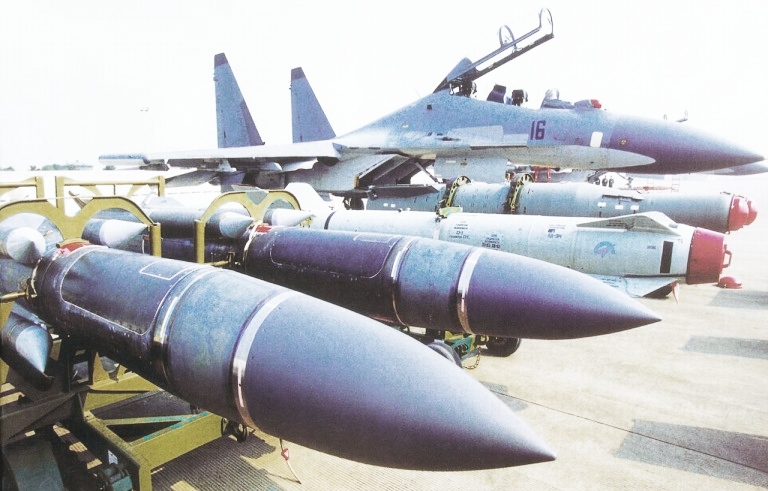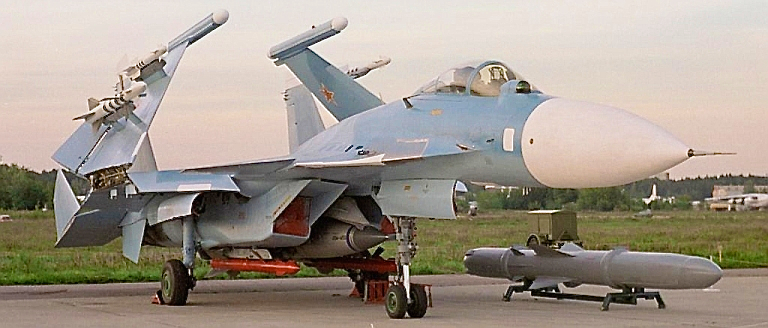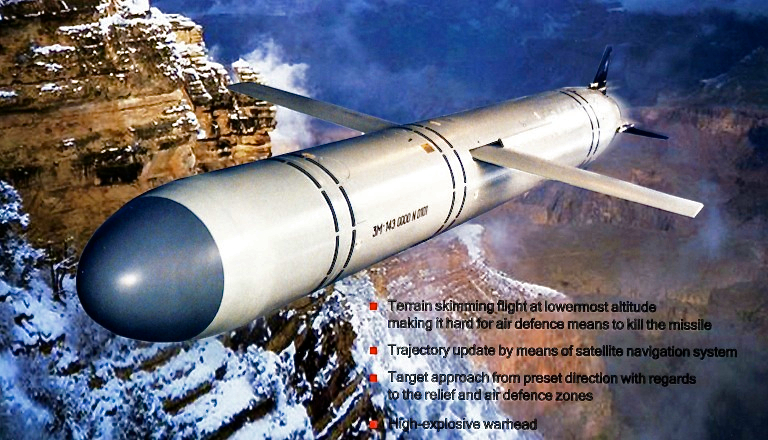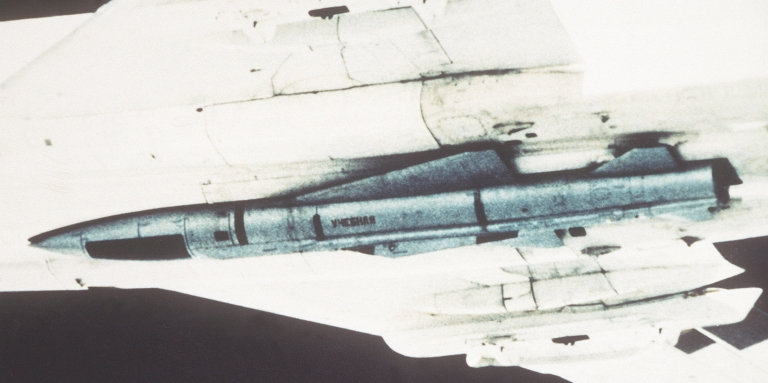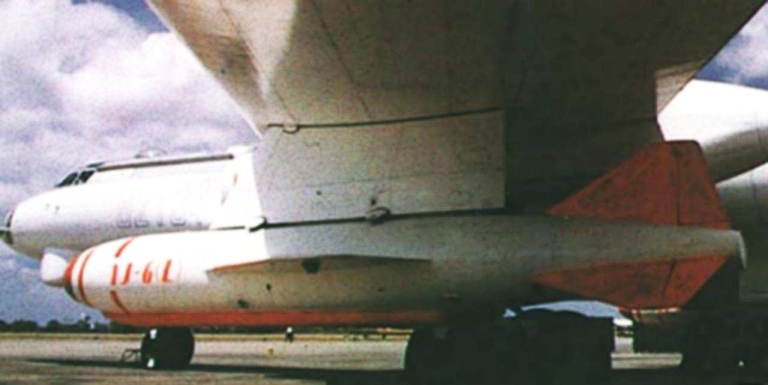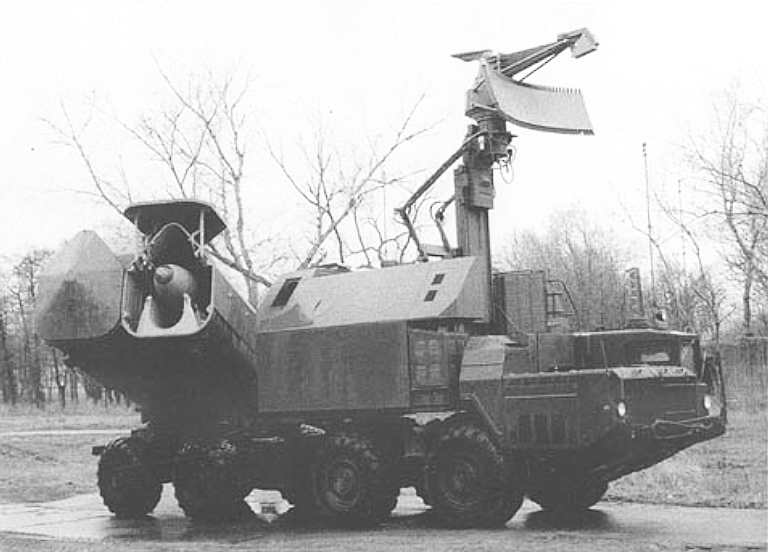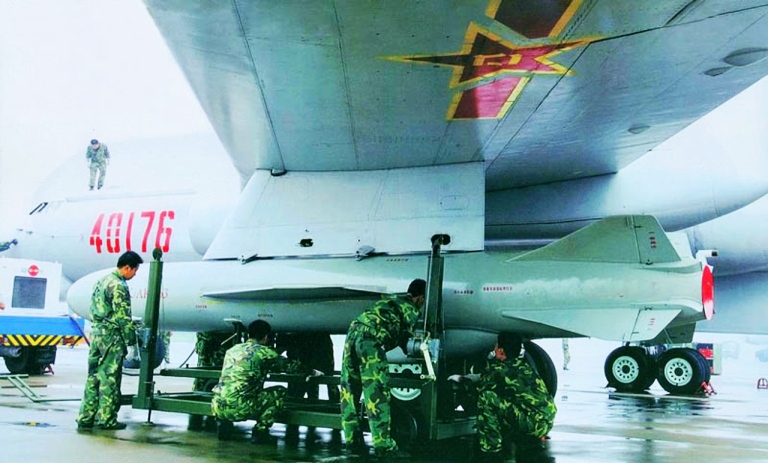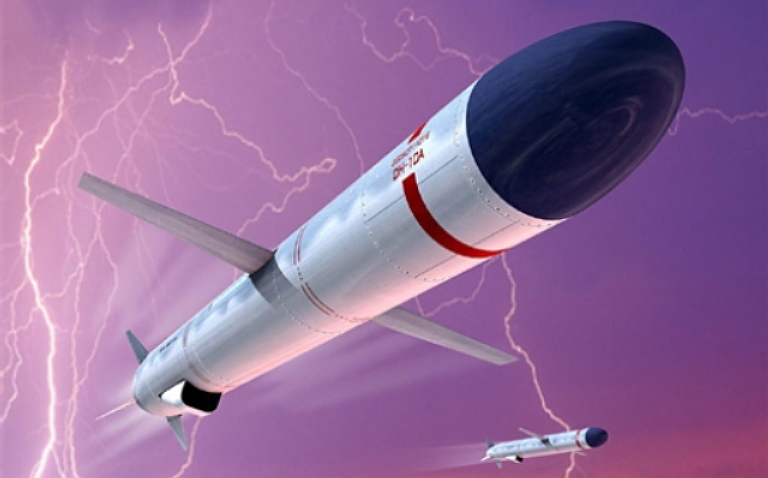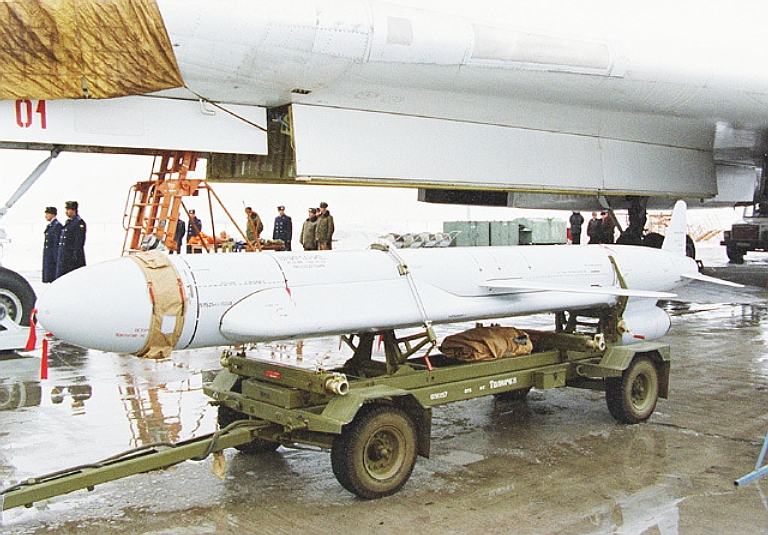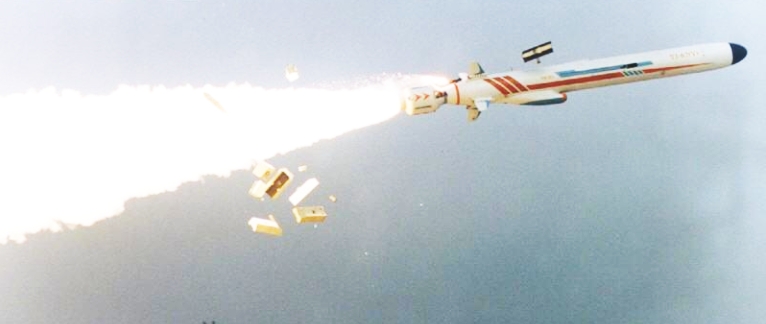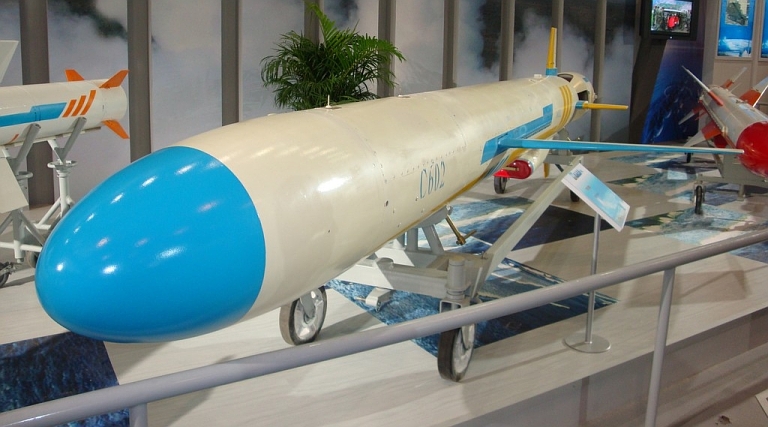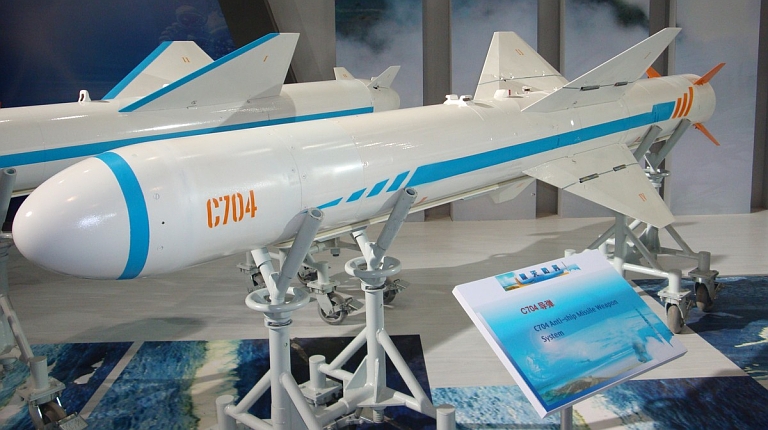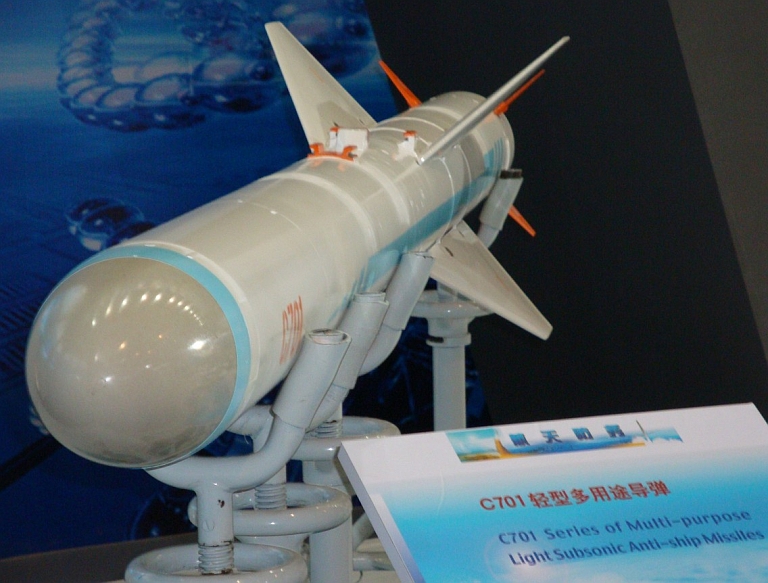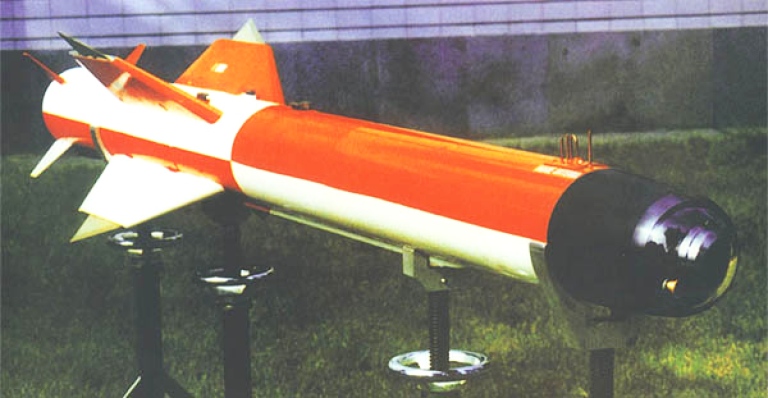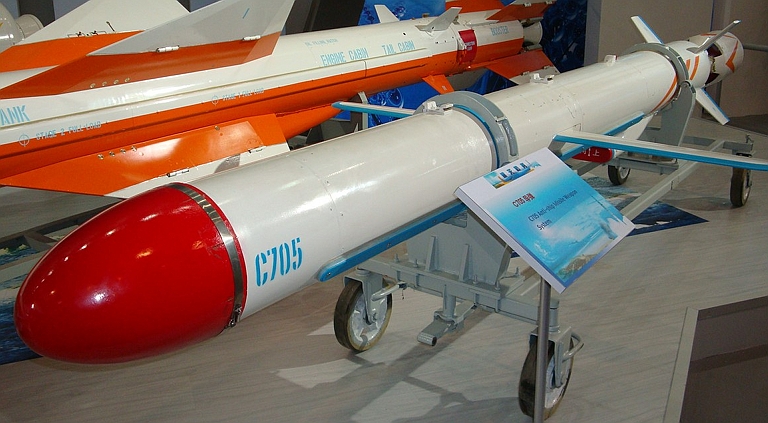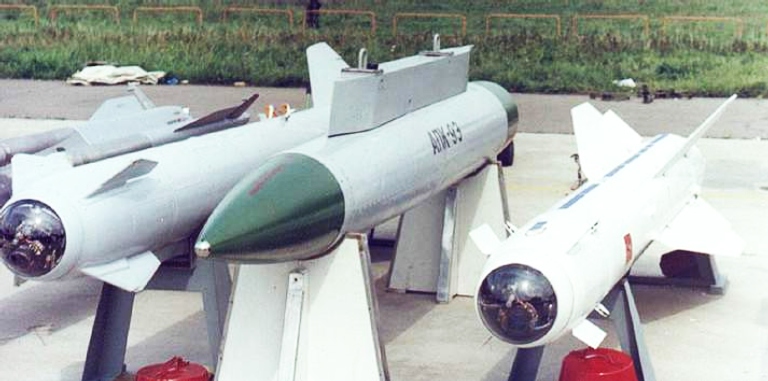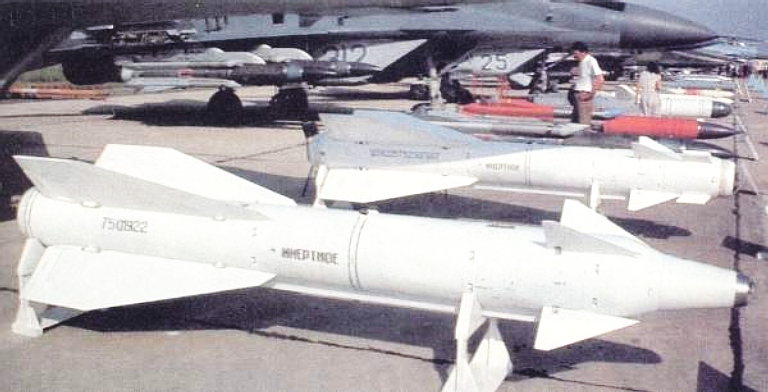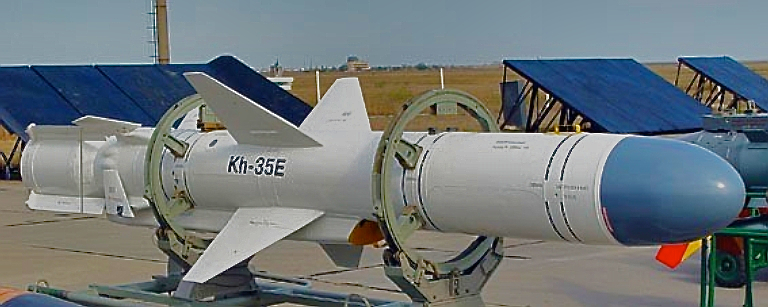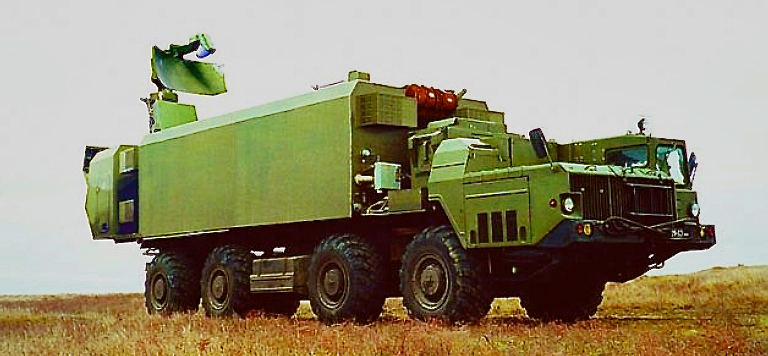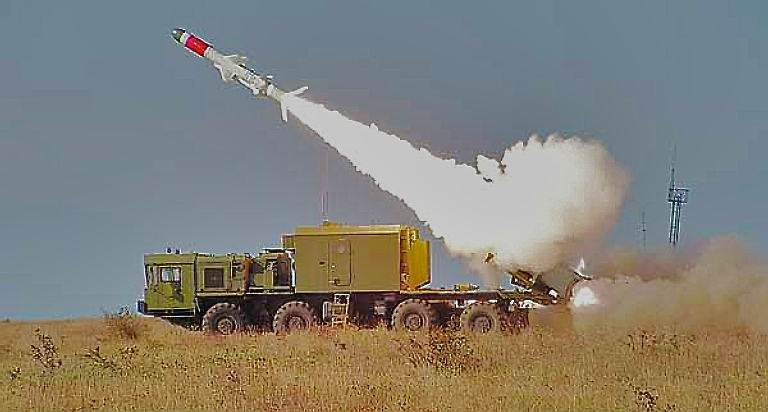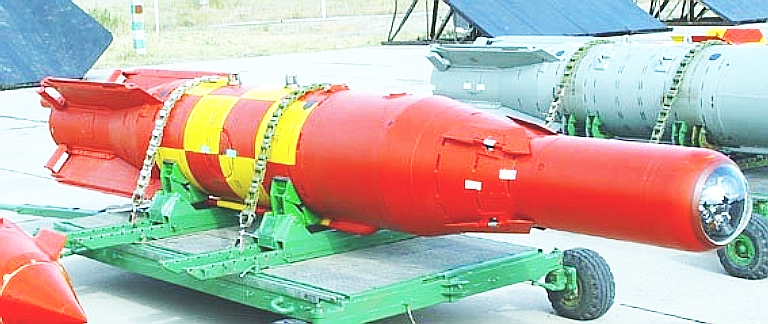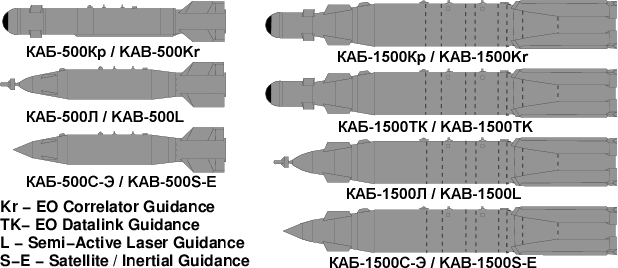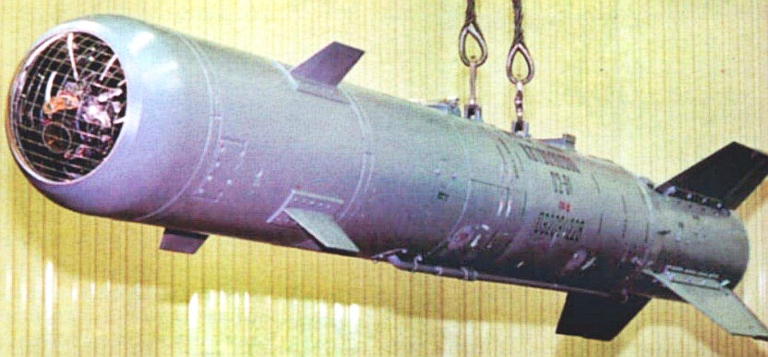|
||||||||||||||||||||||
![Home - Air Power Australia Website [Click for more ...]](APA/APA-Title-Main.png) |
||||||||||||||||||||||
![Sukhoi PAK-FA and Flanker Index Page [Click for more ...]](APA/flanker.png) |
![F-35 Joint Strike Fighter Index Page [Click for more ...]](APA/jsf.png) |
![Weapons Technology Index Page [Click for more ...]](APA/weps.png) |
![News and Media Related Material Index Page [Click for more ...]](APA/media.png) |
|||||||||||||||||||
![Surface to Air Missile Systems / Integrated Air Defence Systems Index Page [Click for more ...]](APA/sams-iads.png) |
![Ballistic Missiles and Missile Defence Page [Click for more ...]](APA/msls-bmd.png) |
![Air Power and National Military Strategy Index Page [Click for more ...]](APA/strategy.png) |
![Military Aviation Historical Topics Index Page [Click for more ...]](APA/history.png)
|
![Intelligence, Surveillance and Reconnaissance and Network Centric Warfare Index Page [Click for more ...]](APA/isr-ncw.png) |
![Information Warfare / Operations and Electronic Warfare Index Page [Click for more ...]](APA/iw.png) |
![Systems and Basic Technology Index Page [Click for more ...]](APA/technology.png) |
![Related Links Index Page [Click for more ...]](APA/links.png) |
|||||||||||||||
![Homepage of Australia's First Online Journal Covering Air Power Issues (ISSN 1832-2433) [Click for more ...]](APA/apa-analyses.png) |
||||||||||||||||||||||
| Last Updated: Mon Jan 27 11:18:09 UTC 2014 | ||||||||||||||||||||||
|
||||||||||||||||||||||
|
Precision
Guided Munitions in the Region
Technical Report APA-TR-2007-0109 |
||||||||||||||||||||||||||||||||||||||||||||||||||||||||||||||||||||||||||||||||||||||||||||||||||||||||||||||||||||||||||||||||||||||||||||
| by
Dr Carlo Kopp, AFAIAA, SMIEEE, PEng January, 2007 Revised June 2008 Revised July 2009 Revised August 2009 Text © 2004 - 2012 Carlo Kopp Line Artwork © 2007 Carlo Kopp   |
||||||||||||||||||||||||||||||||||||||||||||||||||||||||||||||||||||||||||||||||||||||||||||||||||||||||||||||||||||||||||||||||||||||||||||
|
Background
|
||||||||||||||||||||||||||||||||||||||||||||||||||||||||||||||||||||||||||||||||||||||||||||||||||||||||||||||||||||||||||||||||||||||||||||
Technical AnalysesA more detailed discussion of the all the weapons in this analysis can be found under the following analyses. These also include a range of weapons which have yet to be deployed in the region, but are being actively marketed. Soviet/Russian Guided Bombs
PLA Guided Bombs Soviet/Russian Cruise Missiles PLA Cruise Missiles / PLA Air - Surface Missiles Soviet/Russian Tactical Air to Surface Missiles Bypassing the National Missile Defence System - Cruise Missile Proliferation Hard Kill Counter ISR Programs |
||||||||||||||||||||||||||||||||||||||||||||||||||||||||||||||||||||||||||||||||||||||||||||||||||||||||||||||||||||||||||||||||||||||||||||
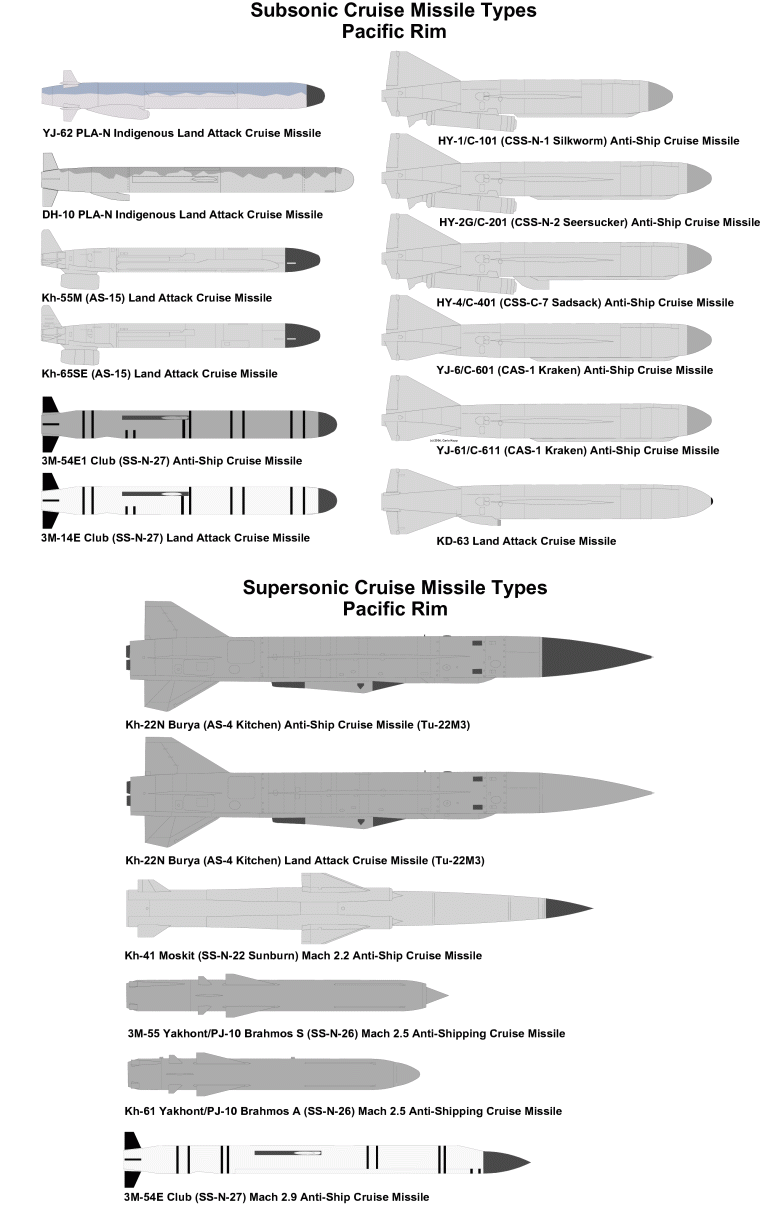 |
||||||||||||||||||||||||||||||||||||||||||||||||||||||||||||||||||||||||||||||||||||||||||||||||||||||||||||||||||||||||||||||||||||||||||||
Precision Guided Munitions |
||||||||||||||||||||||||||||||||||||||||||||||||||||||||||||||||||||||||||||||||||||||||||||||||||||||||||||||||||||||||||||||||||||||||||||
|
NPO Mashinostroyenia 3K-55/3M-55/Kh-61 Yakhont/PJ-10 Brahmos A/S
Kh-61
Yakhont
on
Su-33
Flanker D. Note the centreline Kh-41 Moskit / Sunburn. The shining star in the current export lineup of Russian
weapons is the Yakhont, recently licenced by India as the Brahmos A and
Brahmos S. China is reported to have purchased the baseline 3M-55 for a
number of naval vessels. The OKB-52 3K-55/3M-55 Yakhont (SS-N-26) is like the Moskit a complete family of supersonic rocket-ramjet missiles. Ship, submarine, air and ground launched variants exist. The missile weighs 3 tonnes at launch, and uses a liquid propellant for the ramjet which propels it at speeds between Mach 2.0 and 2.5. The Yakhont typically cruises to the target area at high altitude, and then descends for a sea skimming attack from under the horizon. The distance at which it begins its descent can be programmed before launch, this determining the achievable range which is between 65 and 160 nautical miles( Refer Tsarev V., Melnikov V., 'Yakhont - New Generation Antiship Missile', Military Parade, Exclusives, 2000.). Indian promotional materials indicate guidance improvements to the Brahmos over the original design, and the intent to deploy shipboard, mobile coastal defence and air delivered variants. There has also been speculation about a land attack or dual role variant, requiring a more accurate midcourse navigation system. At 6,000+ lb launch weight, the Yakhont/Brahmos would be carried by Su-27/30 on a centreline adaptor. |
||||||||||||||||||||||||||||||||||||||||||||||||||||||||||||||||||||||||||||||||||||||||||||||||||||||||||||||||||||||||||||||||||||||||||||
|
Raduga 3M80, 3M81, 3M82 and Kh-41/ASM-MSS Moskit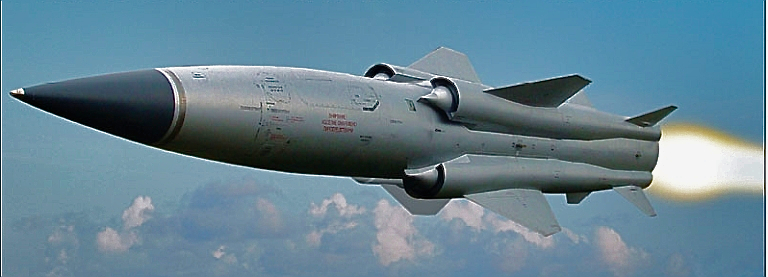
The Raduga 3M-80, 3M-82 and Kh-41 Moskit (SS-N-22 Sunburn) are
all variants of the same 4.5 tonne supersonic rocket-ramjet missile.
This weapon is the primary armament of the PLA-N's new 956E Sovremennyy
class destroyers and is credited with a range between 50 and 120
nautical miles. An air launch centreline tunnel adaptor enables
Su-27/30 family strike fighters to carry a single round and this
configuration has been displayed on the navalised Su-33. A coastal
defence variant labelled the Moskit E is in development, with a two
round TEL based on the MZKT-7930 chassis. Inertial midcourse guidance is supplemented with an Altair active radar seeker - there are no reports to date of land attack derivatives. Unlike subsonic Western anti-ship missiles such as the Harpoon
and Exocet, the Moskit is a supersonic sea-skimmer. It can be
programmed to fly a high altitude trajectory at Mach 3, or a
sea-skimming trajectory at Mach 2.2. If the sea skimming mode is
chosen, the missile will be first detected by a warship under attack
when it emerges over the horizon at a distance of about 15 to 25
nautical miles. This provides the defences on the ship with about 25-60
seconds of warning time before impact. The raw speed of the Moskit
makes it a challenging target for most shipboard defences. |
||||||||||||||||||||||||||||||||||||||||||||||||||||||||||||||||||||||||||||||||||||||||||||||||||||||||||||||||||||||||||||||||||||||||||||
|
Novator 3M54/3M14 Club
3M54E1
Sizzler
subsonic
ASCM
(Novator)
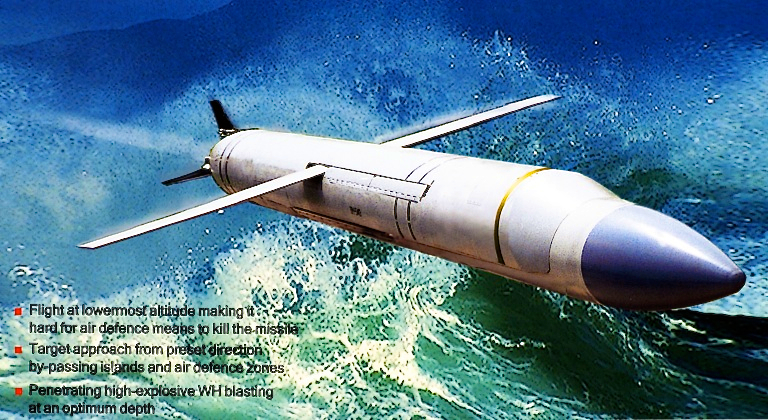 3M54E Sizzler supersonic
ASCM. The supersonic kill
stage is carried to the target area by a subsonic cruise airframe
(Novator)
The Novator 3M-54 Club (SS-N-27 Sizzler) comprises a complete family of ship (Club N), submarine (Club S) and air launched weapons. Unlike warship launched Moskit and Yakont variants, the Club is designed for launch from a 533 mm torpedo tube, or a vertical launch tube( Refer Military Parade, 2000-1 Exclusives Issue, Kamnev P., 'The Club Missile System'). Five distinct variants of this weapon exist. The basic 3M-54E1 and 3M-14E most closely resemble the US Navy's anti-ship and land attack Tomahawk missile. This weapon has a range of 160 nautical miles and is subsonic. The 3M-54E1 uses an ARGS-54 active radar seeker and Glonass satellite and inertial guidance, the 3M-14E Glonass satellite and inertial guidance alone. The more advanced 3M-54E combines the subsonic cruise airframe of the 3M-54E1/3M-14E with a Mach 2.9 rocket propelled guided payload. Like its subsonic sibling, it approaches from under the radar horizon using the same radar seeker to detect its target. Once locked on, it discards the cruise airframe, fires its rocket motor, and accelerates to Mach 2.9 at a sea skimming altitude of 15 feet. Novator claim the missile follows a zig-zag flightpath to defeat defences. Both the 3M-54E1 and 3M-54E are small weapons which are difficult to detect on radar, especially should even basic radar signature reduction techniques be applied to them. The 91RE1 and 91RE2 are rocket boosted homing torpedoes, most closely resembling the US ASROC and Sea Lance weapons. All five weapons in this family share a common launch system and thus any ship, submarine or aircraft equipped for these weapons can carry an arbitrary mix. Press reports indicate that India has fielded this weapon, and
there are claims China also ordered in a 'tit-for-tat' deal for planned
Kilo SSKs. The air launched variant has been marketed on the Su-32FN/34
but there are no reports as yet of hard sales.
|
||||||||||||||||||||||||||||||||||||||||||||||||||||||||||||||||||||||||||||||||||||||||||||||||||||||||||||||||||||||||||||||||||||||||||||
Raduga Kh-22M Burya
The mighty Kh-22 (AS-4 Kitchen) was the weapon which stimulated the development of the SPY-1 Aegis system. Designed during the 1960s for dual role use as a nuclear armed standoff weapon equivalent to the RAF's Blue Steel, and as an anti-shipping missile with either radar or anti-radiation seekers, the Kh-22 remains in service as the primary armament of the RuAF's residual fleet of Tu-22M3 Backfires. While the Tu-95K-22 Bear G was equipped to carry up to three Kh-22s, its progressive retirement has limited use to the Backfire. The Kh-22 is a formidable weapon by any measure, powered by an Isayev R-201-300 (S5.33) liquid rocket delivering 83 kN full thrust and 5.9 kN cruise thrust, it is claimed to exceed 4.6 Mach in cruise at 80,000 ft AGL. Around 3 tonnes of propellant and oxidiser are carried - the highly toxic fuel presents serious handling problems in fuelling up the missile (these Isayev liquid fuel engines ran with AK-20K oxidiser - 80% nitric acid, 20% N2O4 with fluorine or iodine additives and TG02 fuel - 50% xylidine and 50% triethylamine). Cited range varies between 145 NMI (270 km) and 300 NMI (550 km), subject to variant and launch speed/altitude. Russian sources claim the 900 kg shaped charge warhead will blow a 5 metre diameter hole, penetrating 12 metres deep, when impacting a large warship. Seven variants have been reported to date, and a mid life upgrade for the APK-22 guidance package has also been recently reported. Nuclear armed variants included a TERCOM system to supplement the inertial unit. If China proceeds with the much speculated upon Backfire purchase, the Kh-22 is likely to be supplied as the basic weapon for the aircraft. The Backfire carries up to three rounds, although typical payloads are one or two, on BD-45K/F adaptors. |
||||||||||||||||||||||||||||||||||||||||||||||||||||||||||||||||||||||||||||||||||||||||||||||||||||||||||||||||||||||||||||||||||||||||||||
|
HY-1/HY-2/HY-4 Silkworm/Seersucker and C-601/C-611 Kraken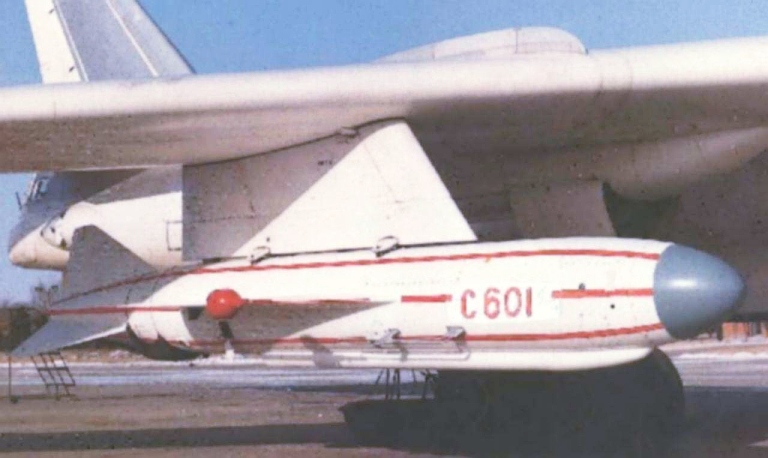
CAS-1
Kraken on a H-6D Badger (PLA-N)
When the Raduga bureau designed
the P-15/4K-40 Termit (SS-N-2
Styx) anti-ship missile during the late 1950s, little could they have
imagined that it would remain in production a half century later. The
original Styx was powered by an Isayev P-15 liquid rocket rated at
1.213-0.554 tonnes thrust, using toxic AK-20K/TG-02 propellant, armed
with an 1,100 lb (513 kg) shaped charge warhead and fitted with a
con-scan active radar seeker. The weapon's first kill was the Israeli
warship Eilat in 1967.
Cloned Chinese Styxes entered production in 1974 as the HY-1/SY-1 or CSS-N-1 Silkworm coastal defence and shipborne ASM. The Chinese soon improved the design, the stretched 6,600 lb (3,000 kg) HY-2 (C-201) or CSS-N-2 Seersucker carrying more propellant and achieving a range of up to 73 NMI (135 km). Many derivative followed, including models with infrared homing seekers, television seekers, monopulse radar seekers and the turbojet powered HY-4. The air launched YJ-6/C-601 or CAS-1 Kraken entered production during the mid 1980s, based on the HY-2 variant, and is carried by naval H-6D Badgers. It was superceded in production by the YJ-61/C-611 with improved 110 NMI (200 km) range via higher energy propellant. Iran acquired several hundred HY-2s and used the missile extensively during the 'tanker war'. It is now claimed that Iran is manufacturing its own clones of the HY-2 and HY-4. While the Silkworm/Seersucker is a subsonic sea skimmer, it
sheer size adds significant lethality. While it is often not regarded
to be a serious threat to surface warships, it has the killing power to
be a very effective blockade weapon against civilian shipping and naval
transports, or amphibious vessels. Iraq used the HY-2 as a land attack
cruise missile prior to
the fall of Saddam, five were launched and most were neither detected
nor engaged by Patriot batteries due to their low level cruise profile
over flat terrain. Papers by US analyst Dennis Gormley repeatedly note
the ease with which the land mobile turbojet powered HY-4 could be
stretched to provide a 380 NMI (700 km) class cruise missile, equipped
with GPS/IMU accurate enough to present a genuine risk to coalition
ground forces. With thousands of cloned Styx derivatives worldwide,
this early Cold War relic may remain a viable weapon in coming decades. 4K51 Rubezh Coastal Defence System
4K51
Rubezh
(SSC-3) coastal defence ASCM TELAR in deployed configuration. CHETA KD-63
The recently revealed KD-63 is a
derivative of the air-breathing HY-4 Sadsack. While it retains the
delta wing and fuselage shape of the HY-4, it uses a new cruciform tail
design, and includes a television / datalink terminal guidance package.
It is thus a dual role weapon, capable of precision strikes against
land and maritime targets. It is carried by the newly designed H-6H
Badger variant, replacing the pair of Krakens carried by earlier
variants. Range is cited at around 100 nautical miles. |
||||||||||||||||||||||||||||||||||||||||||||||||||||||||||||||||||||||||||||||||||||||||||||||||||||||||||||||||||||||||||||||||||||||||||||
|
Chinese Land Attack Cruise Missiles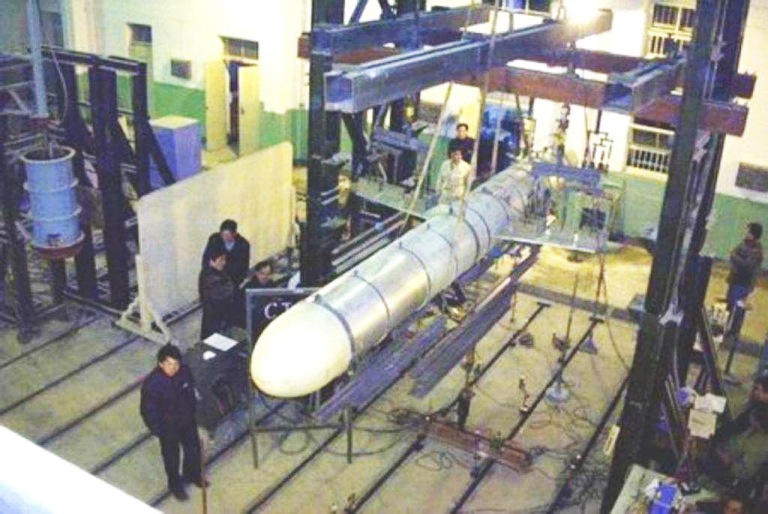 Undesignated
PLA cruise missile, possibly a DH-10 prototype. China has had a long running program aimed at developing land
attack cruise missiles suitable for aerial, sub and ship deployment.
Reports abound claiming the PRC has actively shopped the Middle East
for debris from expended or failed Tomahawk rounds. More recently
reports have emerged claiming China has purchased tooling for the
Raduga Kh-65SE, the reduced range export variant of the Kh-55 (AS-15
Kent) which is Russia's answer to the Boeing AGM-86B ALCM. Many sources
claim that the PLA now operates the indigenous HN-1 (320 NMI/600 km),
HN-2 (800+ NMI/1,500+ km) and the HN-3 (1,350 NMI/2,500 km). The sole
good quality image to emerge suggests these weapons are clones of the
BGM-109 Tomahawk, suitable for naval and aerial launch. The DH-10
cruise missile, declared operational, also resembles a Tomahawk. Given the availability of Russian TERCOM, DSMAC, Glonass,
Western GPS and computer technology, the only issue for the PLA will
lie in good quality 12 inch 600 lb class turbofan availability to power
a genuine AGM-86/BGM-109 class strategic cruise missile. With
submarines, surface warships and H-6H Badgers, there is no shortage of
launch platforms. The recently unveiled H-6H variant with four wing
pylons is clearly intended for such a role.
|
||||||||||||||||||||||||||||||||||||||||||||||||||||||||||||||||||||||||||||||||||||||||||||||||||||||||||||||||||||||||||||||||||||||||||||
|
Raduga
Kh-55SM Kent with conformal fuel tanks.
China is known to have illegally
acquired, in a joint operation with Iran, several examples of the
Kh-55SM Kent cruise missile from storage in the Ukraine, including some
ground equipment. The cost of the investment suggests an interest in
partial or complete reverse engineering of this missile. The Kh-55 family of cruise missiles owes its origins to a series of internal studies at the Raduga OKB during the early 1970s. Raduga were unsuccessful initially in convincing the Soviet leadership of the value of their concept, but this changed as public knowledge of the US AGM-86 Air Launched Cruise Missile program became better known in the Soviet Union. Russian sources claim that Raduga's early work on these weapons was opposed by many Russian experts who were deeply sceptical of the viability of such a complex new weapon. The Kh-55 family of weapons most closely resemble the early US BGM-109 Tomahawk in concept, using a cylindrical fuselage with pop out planar wings, unfolding tail control surfaces, and a ventral turbofan engine, with guidance provided by a TERrain COntour Matching (TERCOM) aided inertial navigation system. The most visible difference between the Tomahawk and Kh-55 families of missiles is the engine installation. The Tomahawk's Williams F107-WR100 engine is embedded in the tail and uses a ventral inlet duct and tailcone exhaust. The Kh-55's Omsk AMKB TVD-50 two spool turbofan is mounted in a nacelle which is stowed in the aft fuselage and deploys via a ventral door on a pylon after launch. The TVD-50 is a critical piece of technology in the Kh-55 as it is a compact and fuel efficient turbofan in the thrust and size class required to power cruise missiles, standoff missiles and UAVs. The cited thrust rating is 400 to 500 kp (880 to 1,000 lbf), with a dry mass of 95 kg (210 lb), a Specific Fuel Consumption of 0.65, a length of 0.85 m (33.5 in) and diameter of 0.33 m (13 in). The Tomahawk uses a four surface tail control assembly with anhedral on the stabilators, whereas the Kh-55 uses only three larger surfaces, with more pronounced anhedral, a configuration since adopted in the new Block IV RGM/UGM-109E Tomahawk Land Attack Missile. The largely symmetrical aft fuselage of the Tomahawk differs from the more pronounced sculpting of the Kh-55 aft fuselage. The cylindrical fuselage configuration is essentially the same for both designs. The Tomahawk has a 21 in diameter, the Kh-55 a 20.5 in diameter, the Tomahawk weighed 2,700 lb at launch, the Kh-55 2,870 lb. The later blocks of the Tomahawk have a chinned 'Beluga' nose to reduce radar signature, the Kh-55 retains an ogival/spherical nose. The baseline guidance package on both missiles is designed around a digital computer running Kalman filter and TERCOM software, with an onboard memory storing a digital map, coupled to a radar altimeter for terrain profiling and a low drift inertial unit. Tomahawks later acquired an optical Digital Scene Matching Area Correlator and GPS - the Soviet had DSMAC technology but it has never been disclosed whether this was added to the Kh-55 series. The cited designation for the Kh-55 guidance package is the Sprut and BSU-55. Like the Tomahawk, the Kh-55 spawned a range of derivatives, unlike the Tomahawk the Kh-55 became the dominant air launched weapon. The first generation of Kh-55s appeared in three configurations, entering service in 1984. The 'Izdeliye 120' Kh-55 / AS-15A was air launched from the Tu-95MS using a MKU-6-5 rotary launcher and external pylons, the RKV-500A / SS-N-21 Sampson was tube launched from the Type 671 Victor, Type 945 Sierra and Type 971 Akula submarines, and the RK-55 / SSC-X-4 Slingshot tube launched from a MAZ-543M (MAZ-7910) 8x8 TEL, carrying six rounds. The air launched Kh-55 was followed by the improved 'Izdeliye 124' Kh-55OK, which was supplanted in production by the most capable 'Izdeliye 125' Kh-55SM / AS-15B subtype in 1987. The aim of the Kh-55SM design was to further extend the striking range of the basic missile, cited at 1,350 NMI (2,500 km). This was achieved by adding a pair of conformal fuselage fuel tanks, which increased launch weight to 3,750 lb (1,700 kg), but increased cruise range to 1,620 NMI (3,000 km) with a 200 kT warhead fitted. The naval variant of the Kh-55SM was designated the RKV-500B. A conventional derivative of the Kh-55, designated the Kh-555, was recently announced. A lightweight shorter ranging derivative weapon, the Kh-65, has been actively marketed since the 1990s. For all intents and purposes, the
late model Kh-55SM is a heavier
and longer ranging equivalent to the BGM-109B Tomahawk, with
performance closest to the AGM-86B ALCM. |
||||||||||||||||||||||||||||||||||||||||||||||||||||||||||||||||||||||||||||||||||||||||||||||||||||||||||||||||||||||||||||||||||||||||||||
CASIC
YJ-62/C-602 Anti Ship / Land Attack Cruise Missile
|
||||||||||||||||||||||||||||||||||||||||||||||||||||||||||||||||||||||||||||||||||||||||||||||||||||||||||||||||||||||||||||||||||||||||||||
CHETA C-701/C-701KD, C-704/C-704KD, C-705 Anti Ship / Land Attack Cruise Missile
Above C-704 cruise missile with active radar seeker (images © 2009, Zhenguan Studio). The C-701 and C-704 missiles are analogues to the French Exocet family of missiles, available with a range of active radar and electro-optical terminal seekers. 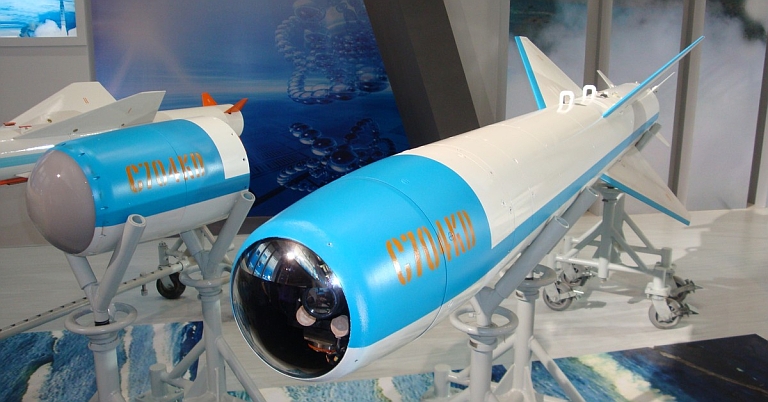 C-704KD
Electro-Optical
variants
with
gimballed TV and IIR seekers, at Zhuhai 2008. The IIR
version uses a Magnesium Fluoride window (images © 2009,
Zhenguan Studio).
C-701KD
variant with
Electro-Optical seeker.
The
C-705 is a planar wing derivative of
the C-701/704 family of weapons. It was first displayed at Zhuhai 2008
(image © 2009,
Zhenguan Studio).
|
||||||||||||||||||||||||||||||||||||||||||||||||||||||||||||||||||||||||||||||||||||||||||||||||||||||||||||||||||||||||||||||||||||||||||||
CHETA YJ-8/YJ-81/C-801, YJ-82/C-802 and YJ-83/C-803 Anti Ship Cruise Missile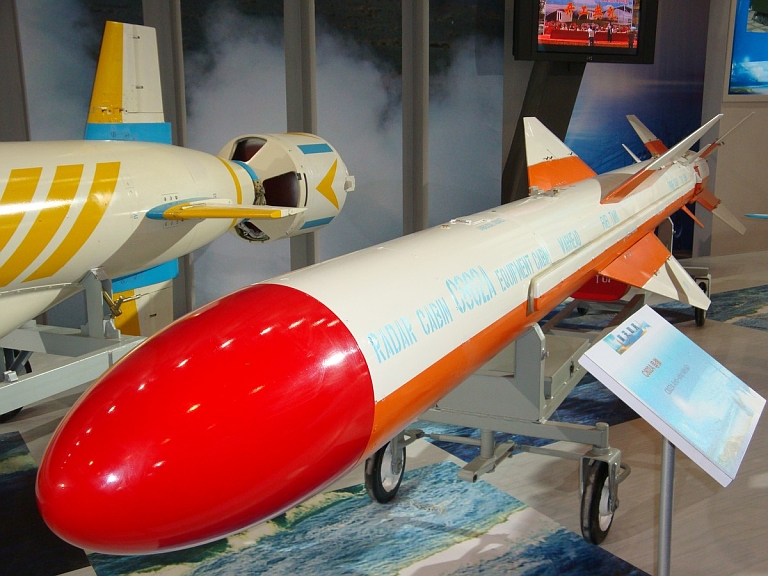
YJ-82/C-802A cruise missile at Zhuhai 2008 (image © 2009,
Zhenguan Studio). China's indigenous response to the Exocet and Harpoon lies in
the YJ-8 (CSS-N-4 Sardine) family of missiles, available in ship, sub,
land and air launch variants. The basic air launch rocket powered YJ-8K
achieves 27 NMI (50 km) range, the improved YJ-81 cca 43 NMI (80 km),
the turbojet YJ-82 (CSS-N-8 Saccade) cca 65 NMI (120 km), and the
recently trialed YJ-83 variant around 135 NMI (250 km). These are the
primary weapon of many PLA-N warships, and the FH-7 maritime fighter
carrying four rounds. |
||||||||||||||||||||||||||||||||||||||||||||||||||||||||||||||||||||||||||||||||||||||||||||||||||||||||||||||||||||||||||||||||||||||||||||
|
Kh-29TE (left) and
APK-9E datalink pod (centre). The
Molniya
Kh-29
/
AS-14 Kedge is a Russian supersonic equivalent
to the French AS.30
and US AGM-65 Maverick, and is primarily intended for interdiction and
close air support, and maritime strike roles. An APU-58 or AKU-58
launcher is used, on the Su-27/30 Flanker (up to 6 rounds), the MiG-27
Flogger (2 rounds), Su-17/22 Fitter (2 rounds) and Su-24M Fencer (3
round). Multiple variants exist. The Kh-28L (Izdeliye 63 or AS-14A) is a semi-active laser
homing variant used in the manner of the AS.30L, with a 24N1
seeker.
The Kh-29T (Izdeliye 64 or AS-14B) is an electro-optical variant with a
TV datalink and command uplink, using the APK-9 Tekon pod. The Kh-29TE
is an enhanced variant. The Kh-29D is another EO variant, equipped with
a thermal imaging seeker. Launch
weight
for
most
variants is around 1,500 lb, with a 700 lb warhead
being used most often. Range is usually cited at 16 nautical miles for
a high altitude launch.
Kh-29L (foreground)
and Kh-29TE
(background).
Zvezda Kh-31P/A/MR/MA 'Mini-Moskit'
The Mach 4.5 ramjet Kh-31P/MP/A/MA Krypton family of missiles includes anti-radiation, anti-shipping and anti-AWACS variants. Reports claim the PRC intends to licence build this weapon, depicted an Su-30KN prototype (KNAAPO). Dubbed the 'Mini-Moskit', the supersonic Turayev ramjet powered Kh-31P (AS-17 Krypton) was originally designed as an anti-radiation missile to suppress NATO Patriot and IHawk batteries, entering use in 1988, with an L-111E family interferometric seeker. Since the end of the Cold War it has evolved an extended range airframe (Kh-31MP / Type 2 - 100+ NMI range). An anti-ship variant equipped with an active radar seeker, the Kh-31A/MA, was recently introduced, adaptation of this seeker permitting counter-ISR roles as an AWACS-Killer. At altitude the Kh-31 achieves Mach 4.5, as sea level Mach 2.7. Su-30MK fitted for the Kh-31 series carry up to six rounds on wing stations 3, 4, 11, 12 and inlet stations 9 and 10, using AKU-58 adaptors, the Su-27SKU four rounds on 3, 4, 9 and 10. It has no equivalent in the Western inventory, the US Navy
using it as the MA-31 target drone. The PLA is reported to use this
weapon with recent claims of plans for licence production. |
||||||||||||||||||||||||||||||||||||||||||||||||||||||||||||||||||||||||||||||||||||||||||||||||||||||||||||||||||||||||||||||||||||||||||||
|
Raduga Kh-59/59M/D Ovod The Kh-59M/D is a direct equivalent to the AGM-142 and the PLA-AF Su-30MKK can carry two rounds. Daylight TV and IIR versions exist (Rosoboronexport). The 2,000 lb (920 kg) 62 NMI (115 km) range Kh-59M/D (AS-18 Kazoo) series stand-off weapon is a direct equivalent to the AGM-142 missile now being integrated on the RAAF's F-111C. Evolved from an anti-radiation missile, it shares the common Granit 7TM1 optical seeker and Raduga APK-9 Tekon DL pod with the KAB series, the D-model fitted with a thermal imager, and uses an RDK-300 jet sustainer. The PLA-N is reported to have ordered an anti-ship variant equipped with a radar seeker, designated the Kh-59MK2, for the Su-30MK2. Su-27SK/30MK fitted for the Kh-59M/MK2 carry two rounds on
wing stations 3 and 4, using AKU-58 adaptors, the pod carried on inlet
station 9.
Kh-59MK2 prototype for the PLA-N Su-30MK2, carried on an Su-24 Fencer. |
||||||||||||||||||||||||||||||||||||||||||||||||||||||||||||||||||||||||||||||||||||||||||||||||||||||||||||||||||||||||||||||||||||||||||||
|
Zvezda 3M-24/Kh-35U Uran
Dubbed the Kharpunski the Kh-35U Uran (AS-20 Kayak/SS-N-25
Switchblade) is the Russian equivalent to the US RGM-84/AGM-84 Harpoon.
The missile is available in surface launched and air launched versions
(AKU-58 adaptor) and was publicly canvassed as an option for India's
Tu-142 Bear upgrade - it is already deployed on the New Delhi class
DDG, reports indicate China ordered in 2001. An ARGS-35 active radar
seeker is used, and there are claims of a 'SLAM-like' land attack
variant although no images are as yet available. Bal E Coastal Defence System
The Bal E is the replacement for the Rubezh coastal defence
system. This design departs from the arrangement of the Rubezh,
the new weapon system is designed around an 8 round TEL armed with the
3M-24 Uran ASCM and a separate command/control and targeting vehicle.
Like the Rubezh, the Bal E employs a command and control vehicle
equipped with an acquisition and targeting radar, and a telescoping
datalink mast to network the TELs. While demonstrators were built on
the MAZ-7910 chassis, production vehicles use the MZKT-7930 chassis.
The stated CONOPS for the Bal E is for batteries to produce saturation
missile attacks against hostile amphibious forces.
Bal
E 'self propelled command/communications and targeting post'
demonstrator on MAZ-7910.
Production
Bal
E
TEL
using MZKT-7930 chassis. Demonstrator on MAZ-7910 [Click here]. |
||||||||||||||||||||||||||||||||||||||||||||||||||||||||||||||||||||||||||||||||||||||||||||||||||||||||||||||||||||||||||||||||||||||||||||
GNPP KAB-1500/KAB-500/KAB-250 Precision Guided Bombs
KAB-1500Kr
Electro-Optically
Guided
Bomb
training round. Russia's family of KAB-1500 and KAB-500 smart bombs are an equivalent to the US Paveway II/III and GBU-15 family of guided bombs. Sharing common design modules with unique seeker designs, and a range of standard warhead types, this family of weapons encompasses all of the baseline capabilities in their US equivalents. The KAB (Korrektiruyeskaya Aviatsionnaya Bomba) family of weapons were developed during the 1970s by Moscow based GNPP, and it is likely that warstocks of the Paveway, Walleye and HOBOS captured in South Vietnam during 1975 played an important role in the design process. The basic configuration of the 500 kg weapons is common to the GBU-8 HOBOS TV guided bomb family using tail controls and fixed canards, less the GBU-8's lift enhancing strakes. The 1,500 kg weapon is closer to a hybrid of the Paveway II and HOBOS configuration, with steerable canards and spring deployed cruciform tail. Two common seekers are currently available across the product
range. The first seeker is the '27N' semi-active laser homing seeker
using a ring airfoil and optical path similar to the Paveway II series
(KAB-500L, KAB-1500L). It will provide similar characteristics to the
baseline Paveway II seeker. The cited 4 metre Circular Error Probable
is however consistent with a proportional control algorithm rather than
the bang-bang design in the Paveway II. A laser designator such as the
Klyon PM/PS, Kaira 24M, I-25 Shkval, or a targeting pod such as the
Sapsan-E would be used, or a Western pod with the laser exciter
configured with Russian seeker coding.
GNPP KAB-500 and KAB-1500 guided bombs (Author) 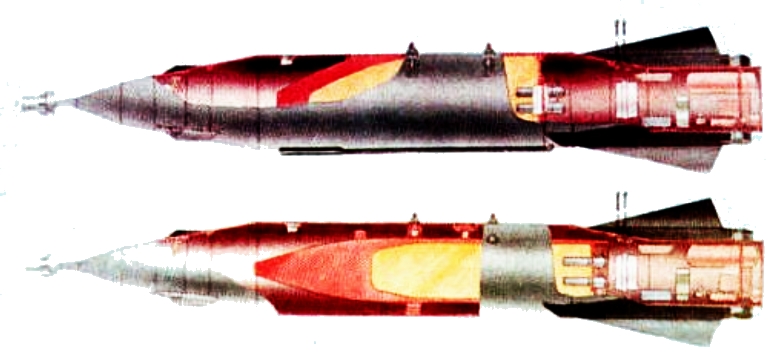 GNPP
KAB-1500L cutaways - blast/frag variant (upper) and penetrator variant
(lower).
The second 7TM1 seeker bears a striking resemblance to the GBU-8/15 configuration, with a gimballed TV camera under a hemispherical dome, and is largely common to the Kh-29TE and Kh-59M standoff missiles. The seeker field of regard would be in excess of 45 degrees off boresight, permitting some flexibility in bomb release. The daylight TV seeker is available with two different guidance packages. The first, designated Televizionno-Komandnaya is a man in the loop command link arrangement similar in concept to the GBU-15 (KAB-1500TK). A Raduga APK-8 or APK-9 datalink pod common to the Kh-59 is used to send steering commands to the bomb, and receive video from the seeker during flight for display in the cockpit. This seeker will achieve similar effect to the GBU-15 and will be extremely accurate. The second guidance package designated 'Korrelatsionaya' employs a Scene Matching Area Correlator package (KAB-500Kr, KAB-1500Kr), which guides the bomb to a set of coordinates within a preprogrammed image surrounding the target - it is similar technology to the DSMAC in the BGM-109 Tomahawk. EU sources claim this guidance package can hit completely hidden targets providing their location is well known relative to visually prominent features surrounding the aimpoint. It is likely the bomb needs to be programmed on the ground, although this is apt to change now with the added computing power in recent Su-30 variants. Multiple rounds can be released in a single pass at multiple aimpoints, not unlike the JDAM. While EU sources speculate on the existence of a thermal imaging variant, its existence cannot be confirmed as no photographs are available showing the Zinc Sulphide or Fluoride glass nose windows required. As Russia's industry is now experimenting with QWIP Focal Plane Array imaging chips, a day/night thermal imaging variant is a likely future prospect. The design changes would be in a revised gimbal with a cooling assembly and an IR transmissive window. The most recent variants are the KAB-500S-E and
KAB-1500S-E, equipped with a satellite/inertial guidance system
analogous to the US JDAM weapons. Their production status is currently
unclear, but trial drops are known to have been performed. The 3,000 lb (1,500 kg) class KAB-1500 bombs are the
heavyweights, with blast, blast fragmentation and subcalibre bunker
busting warhead options, the latter claimed to be capable of
penetrating up to 20 metres of soil and 2 metres of reinforced
concrete. The 1,000 lb (500 kg) class KAB-500 bombs are GBU-16/32/35
equivalents, with blast, submunition dispensing, blast fragmentation
and fuel-air explosive warhead options. The Su-27/30 is cleared to lift
up to 6 KAB-500s or 3 KAB-1500s on wing stations 3 and 4, inlet
stations 9 and 10, and centreline tandem stations 1 and 2. The KAB-500
is carried on a BD-3U adaptor, the KAB-1500 on a BD4 adaptor.
KAB-500SE
satellite aided inertially guided bomb.
KAB-500Kr
Electro-Optically
Guided
Bomb.
KAB-500L
Laser
Guided
Bomb.
KAB-1500L
Laser
Guided
Bomb. |
||||||||||||||||||||||||||||||||||||||||||||||||||||||||||||||||||||||||||||||||||||||||||||||||||||||||||||||||||||||||||||||||||||||||||||
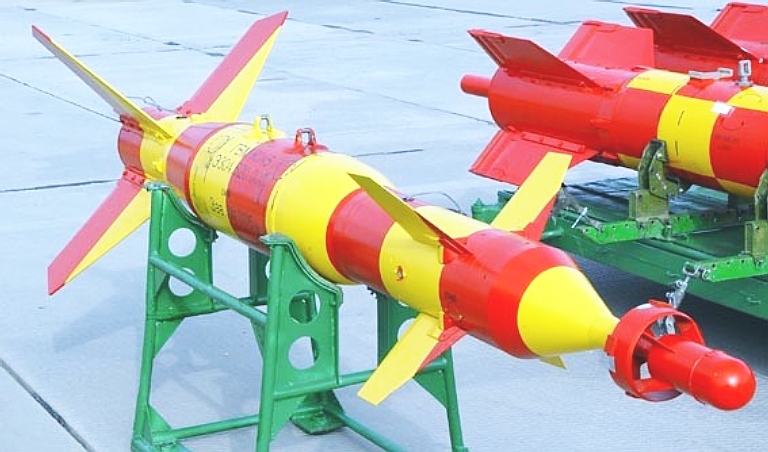 KAB-250L laser guided bomb. |
||||||||||||||||||||||||||||||||||||||||||||||||||||||||||||||||||||||||||||||||||||||||||||||||||||||||||||||||||||||||||||||||||||||||||||
  |
||||||||||||||||||||||||||||||||||||||||||||||||||||||||||||||||||||||||||||||||||||||||||||||||||||||||||||||||||||||||||||||||||||||||||||
Resources/References
|
||||||||||||||||||||||||||||||||||||||||||||||||||||||||||||||||||||||||||||||||||||||||||||||||||||||||||||||||||||||||||||||||||||||||||||
Imagery
Sources: Author;
Rosoboronexport; Russkaya Sila; Xinhua; KnAAPO; MilitaryPhotos.net;
Military.cz
Technical Report APA-TR-2007-0109 |
||||||||||||||||||||||||||||||||||||||||||||||||||||||||||||||||||||||||||||||||||||||||||||||||||||||||||||||||||||||||||||||||||||||||||||
|
|||||||||||||
![Sukhoi PAK-FA and Flanker Index Page [Click for more ...]](APA/flanker.png) |
![F-35 Joint Strike Fighter Index Page [Click for more ...]](APA/jsf.png) |
![Weapons Technology Index Page [Click for more ...]](APA/weps.png) |
![News and Media Related Material Index Page [Click for more ...]](APA/media.png) |
||||||||||
![Surface to Air Missile Systems / Integrated Air Defence Systems Index Page [Click for more ...]](APA/sams-iads.png) |
![Ballistic Missiles and Missile Defence Page [Click for more ...]](APA/msls-bmd.png) |
![Air Power and National Military Strategy Index Page [Click for more ...]](APA/strategy.png) |
![Military Aviation Historical Topics Index Page [Click for more ...]](APA/history.png)
|
![Information Warfare / Operations and Electronic Warfare Index Page [Click for more ...]](APA/iw.png) |
![Systems and Basic Technology Index Page [Click for more ...]](APA/technology.png) |
![Related Links Index Page [Click for more ...]](APA/links.png) |
|||||||
![Homepage of Australia's First Online Journal Covering Air Power Issues (ISSN 1832-2433) [Click for more ...]](APA/apa-analyses.png) |
|||||||||||||
| Artwork, graphic design, layout and text © 2004 - 2014 Carlo Kopp; Text © 2004 - 2014 Peter Goon; All rights reserved. Recommended browsers. Contact webmaster. Site navigation hints. Current hot topics. | |||||||||||||
|
Site Update
Status:
$Revision: 1.753 $
Site History: Notices
and
Updates / NLA Pandora Archive
|
|||||||||||||
|
|
Tweet | Follow @APA_Updates | |||||||||||
|
|
|||||||||||||
|
|
|||||||||||||
![F-111 Aardvark Index Page [Click for more ...]](APA/f-111.png)
![F/A-18 Hornet and Super Hornet Index Page [Click for more ...]](APA/fa-18a.png)
![Aerial Refuelling and Airlift Capabilities Index Page [Click for more ...]](APA/aar-lift.png)
![Directed Energy Weapons and Electromagnetic Bombs Index Page [Click for more ...]](APA/dew.png)
![Notices and Updates Index Page [Click for more ...]](APA/notices-128.png)
![APA NOTAM and Media Release Index Page [Click for more ...]](APA/notams-128.png)
![APA Research Activities and Policy / Technical Reports Index [Click for more ...]](APA/research-128.png)
![Search Air Power Australia Website [Click for more ...]](APA/search-128.png)
![Briefings and Submissions - Air Power Australia [Click for more ...]](APA/briefs-128.png)
![Air Power Australia Contacts [Click for more ...]](APA/contacts-128.png)
![Funding Air Power Australia [Click for more ...]](APA/funding-258.png)
